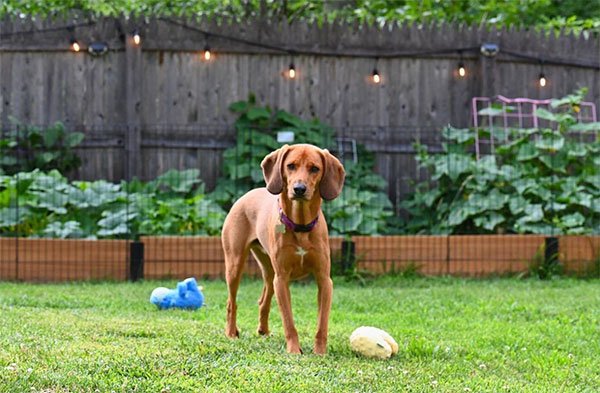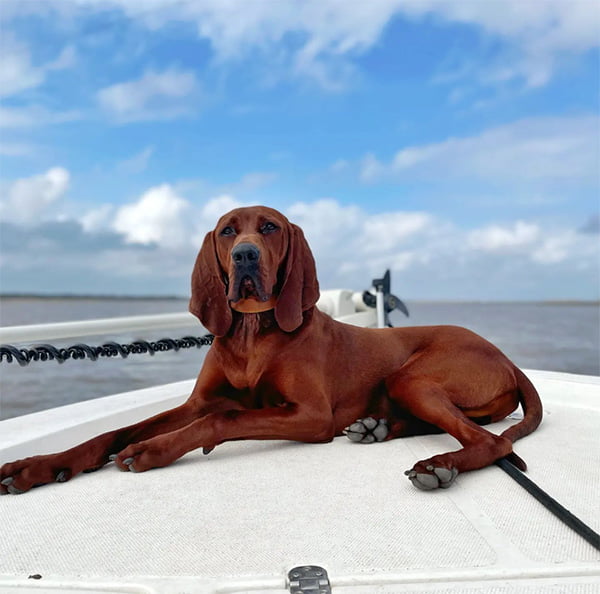The Redbone Coonhound is a stunningly gorgeous hound breed with a winning personality and an appetite for life. These dogs love their people and love to be included in everything their families do. Redbone Coonhound's good manners and laid-back nature makes them great pets to include in life and wonderful, easy daily companions. So is the Redbone Coonhound, the dog for you?
Breed Characteristics
Temperament | Friendly, outgoing |
Intelligence | Average |
Affection/Friendliness | Affectionate |
Trainability | Moderate |
Moderate | |
Exercise Needs | High |
Apartment Living | Not recommended |
Family Friendly | Yes |
Pet Friendly | Yes |
Drooling Level | Low to moderate |
Energy Level | High |
Loneliness Tolerance | Low |
Adaptability | Moderate |
Tendency to bark | High |
Origin of Redbone Coonhounds
The Redbone Coonhound dog breed is a hound group breed that originates in the US, primarily in the southeastern parts of the US, specifically Georgia. They were originally a breed developed from foxhounds brought to the US in the late 18th century by Scottish immigrants. The Redbone Coonhound was bred for raccoon hunting skills and was crossed with Irish hounds and possibly bloodhounds.
The breed was thoroughly established by the late 19th century. United Kennel Club recognized the coonhound breed in 1902. It was the second coonhound breed to gain recognition, and the American Kennel Club recognized it in 2009 into the hound group. However, the breed is still quite rare outside of the US.
While one might assume that their name originated with the striking color of a Redbone Coonhound, the name actually comes from the name of one of the early breeders, Peter Redbone. Original Redbone Coonhounds were not solid red either, and they had a black saddleback, which eventually was bred out, leaving just a solid, deep red mahogany coat.

Breed Overview
Height: 22-27"
Weight: 45-70 lbs
Height: 21-25"
Weight: 45-65 lbs
Breed Group
Hound
Life Span
11-12 years
Coat
Short
Coat Length
Short
Hypoallergenic
No
Shedding Level
Moderate
Size
Redbone Coonhounds are medium to large size dog breeds, growing to heights of 21-27 inches and weighing anywhere from 45 to 70 pounds full grown.
Personality
The Redbone Coonhound has a very mild-mannered and easy-going personality. They are energetic, smart, friendly, loving, independent, and loyal, bringing together all of the best dog qualities in one complex yet mild dog companion.

Image source: Instagram @theycallme_otis
Appearance/Colors
The standard for a Redbone Coonhound is a deep red or mahogany coat, usually always solid red, though a dark muzzle or some white on the chest are still considered acceptable or normal for the breed. Their coats are very short and smooth.
Temperament
The Redbone Coonhound's temperament is very mild. They are great family dogs, but their friendliness will not make them good guard dogs since they are ready to befriend strangers and newcomers of all kinds.
They do well with children though they may not be a good fit for families with very small children due to high energy levels. They are not a clingy breed of dog but still will always want to be included in family activities. They make great companions for individuals with busy lifestyles that they can be included in.
Diet/Nutritional Needs
Dietary needs vary slightly from dog to dog, so always consult your vet about the correct amount of food for your dog's age, size, and lifestyle. Most Redbones will eat about a cup and a half of dry food a day, and it is best to split this up between two meals rather than one big meal or free feeding to reduce digestive issues. Try a slow feeder bowl or automatic dog feeders for small portion meals. These dogs are prone to overeating, so be sure to monitor your dog's eating and what treats or food scraps he is getting to ensure that your dog does not gain unhealthy weight.
Activity/Exercise Needs
One of the main considerations when determining if the Redbone Coonhound is a good choice for you is whether you have the time and availability to keep up with their relatively high exercise needs. As an energetic hunting breed, Redbone Coonhounds will need a lot of daily exercises to keep out of trouble and stay in optimal health.
A Redbone Coonhound will need at least 90 minutes of exercise daily, either in walking, jogging, running, dog sports, or swimming. They are easily bored, so it is good to switch it up often and let them explore new places to keep them engaged. This is not a breed of dog you should ever let off leash if you are not in a safely fenced-in area. As scent-hounds, they will take off after a smell that piques their interest and will take off fast and far margin them very hard to get back. They are prone to wanderlust, so, in addition to rigorous training, you will want to ensure that you always keep your Redbone on a leash whenever you are out and about.
Grooming Needs
One thing that makes Redbone Coonhounds an attractive choice is that they are pretty low maintenance when it comes to grooming. Their short coats don't shed much and can be easily kept under control with a weekly brushing. The dog hair stays relatively clean and only needs to be bathed as needed.
Their floppy ears will require careful inspection and regular cleaning to check for and prevent irritation or infection. You will want to get in the habit of brushing your puppy's teeth a few times a week so that it adjusts as it grows up. Nails should be kept short to prevent tearing or splitting. This breed has a mild potential for drooling but is not nearly as high as other coonhound breeds.
Adaptability
Redbone Coonhounds are fairly flexible and adaptable dogs. They are not clingy and can handle being on their own for small amounts of time, provided they have acceptable ways to entertain themselves. They are prone to loud baying, which can be problematic for apartment living.
Redbone Coonhound's high prey drive may make relationships with other pets challenging. Still, if they are socialized well when they are puppies and introduced to household pets at a young age, they can usually be taught to respect smaller pets' space. As far as coonhound breeds go, they are one of the better breeds when it comes to being able to learn to get along with smaller pets.
Trainability of Redbone Coonhound Puppies
One of the challenges of owning a Redbone Coon hound puppy is that they have a relatively short attention span and are very easily distracted. It will take a lot of patience, consistency, and positive reinforcement to train these dogs adequately.
While they pick up hunting training quickly, they find some basic training mundane. They are also a breed prone to canine attention deficit disorder (ADD), can be stubborn, and use their intelligence to interpret commands rather than simply obeying them creatively. Short, ten-minute training sessions several times during the day is your best route when it comes to training a Redbone Coonhound.

Image source: Instagram @gentlejakescoonhound
Life Expectancy
A healthy Redbone Coonhound can live as long as 10-12 years.
Potential Health Issues
The Redbone Coonhound is one of the more relatively healthy dogs. Most of the health issues Redbone's have are related to physical injuries they get while on the hunt and genetic conditions that come as a result of improper breeding standards.
Hip Dysplasia
Hip dysplasia is a hereditary condition that results in the malformation of a dog's joints. Sometimes hip dysplasia shows up during puppyhood and sometimes not until later in life.
There is little that can be done to prevent it. But only buying from reputable redbone breeders who are breeding responsibly can help.
Ear Infections
Dogs with floppy ears are prone to a number of ear issues and infections, including—
- Ear mites
- Bacterial infection, or otitis externa
- Foreign objects becoming lodged or stuck
The most effective way to prevent ear infections in dogs is to clean their ears regularly and to clean them well with the correct dog ear cleaner.
